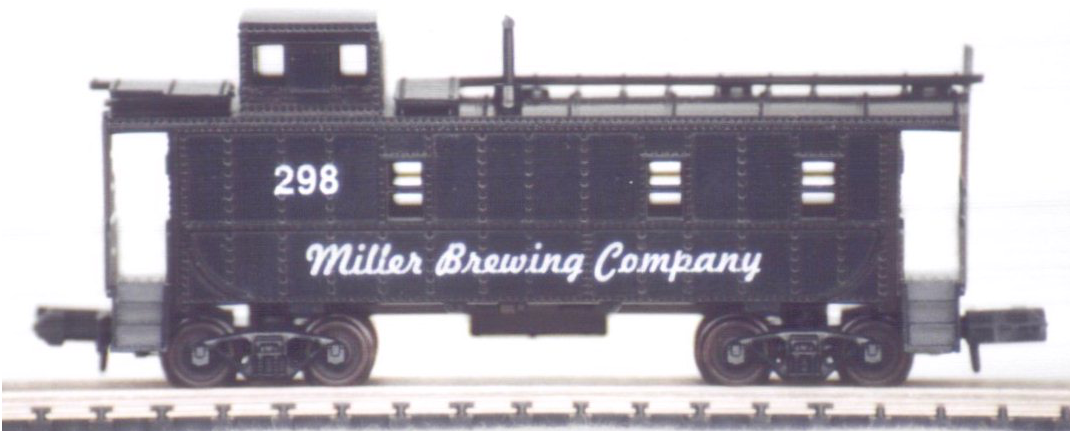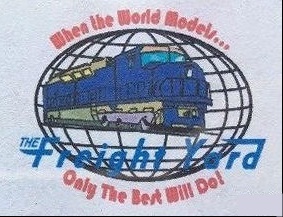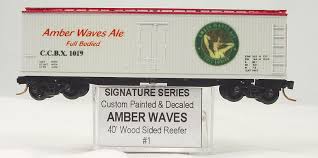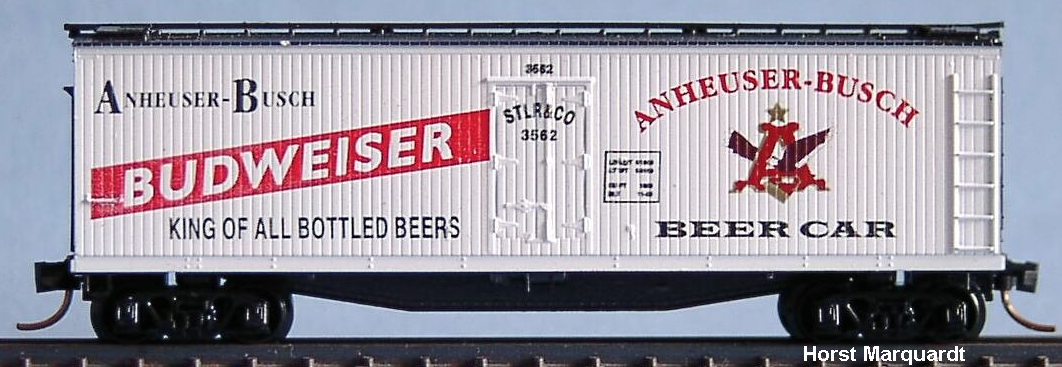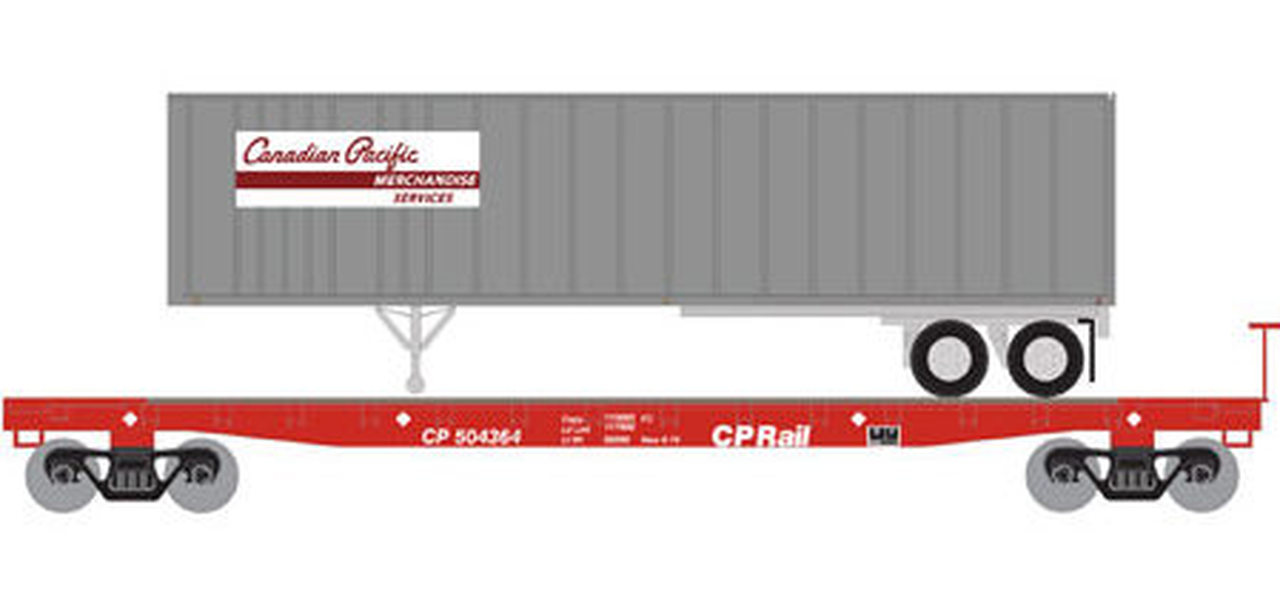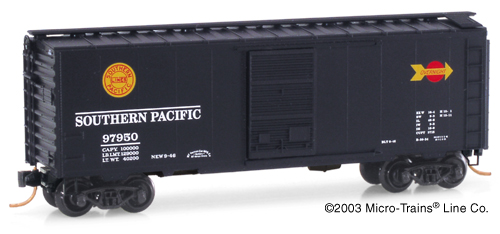The Freight Yard - 2022A - Caboose, Cupola, Steel - Miller Brewing - 277
| Stock Number | 2022A |
| Original Retail Price | $14.30 |
| Brand | The Freight Yard |
| Manufacturer | Atlas |
| Body Style | Atlas Caboose Cupola Offset 8-Window |
| Prototype Vehicle | Caboose, Cupola, Steel (Details) |
| Road or Company Name | Miller Brewing (Details) |
| Road or Reporting Number | 277 |
| Paint Color(s) | Black |
| Print Color(s) | White |
| Additional Markings/Slogan | Miller Brewing Company |
| Coupler Type | Rapido Hook |
| Coupler Mount | Truck-Mount |
| Wheel Type | Injection Molded Plastic |
| Wheel Profile | Small Flange (Low Profile) |
| Series Name | Premiere Editions |
| Release Date | 2000-05-01 |
| Item Category | Rolling Stock (Freight) |
| Model Type | Caboose |
| Model Subtype | Cupola |
| Model Variety | Offset |
| Prototype Region | North America |
| Prototype Era | NA Era III: Transition (1939 - 1957) |
| Scale | 1/160 |
Specific Item Information:
Atlas model decorated by The Freight Yard.
Model Information:
The "35" series "Offset" Cupola Caboose is an early Atlas body style introduced between 1979 and 1982. It replaced the earlier 6-window version of the offset cupola caboose that was made for Atlas by Roco. The model was first manufactured in Atlas' New Jersey facility but later moved to China. Its cupola is located towards one end of the body hence the nickname "End" or "Offset" Cupola Caboose. This body style has a roofwalk. It has five windows on one side and three on the other (hence it is known as the 8-Window version) as well as two separated windows on each side of the Cupola. It has ladders on each end which do NOT loop over the ends onto the roof.
Prototype History:
The origins of the railroad caboose appear to date back to the 1840s when Nat Williams, a conductor of the Auburn & Syracuse Railroad (a later affiliate of the New York Central) became fed up with cramped and uncomfortable quarters to do paperwork (a common job of the conductor, whose responsibility is general oversight and control of a train, passenger or freight), which was usually done in either a free space of a passenger car or combine/baggage car. To fix this problem, Williams found an unused boxcar and using a simple box and barrel, as a seat and desk, set up shop in the car to do his duties. Not only did he find out he had plenty of room to work but also figured that he could use the unused space to store tools (flags, lanterns, spare parts, etc.) and other essentials to have on board whenever needed (such things become commonly stored on the caboose).
Perhaps the most striking feature ever applied to the railroad caboose was its cupola. According to the story, conductor T.B. Watson of the Chicago & North Western in the 1860s reportedly used a hole in a boxcar’s roof (which he was using as a caboose) to get a better vantage point of the train ahead. It is said that Watson was amazed by the view afforded from the position being able to not only see the train ahead but also from all sides, and to the rear as well. He apparently convinced C&NW shop forces to construct a type of open observation box onto an existing singe-level caboose with windows all around where one could sit and view their surroundings. The rest, as they say, is history and the common cupola was born.
Steel Cabooses replaced their wood-sheathed brethren after the second world war when the steel glut made the production and maintenance of steel cabooses far more efficient than wooden models. With the advancement of the End-of-Train device, cabooses slowly began to fall out of favor. However, in the early 2000’s, “shoving platforms” began to appear as a place to safely house a crew when a reverse move was required. Instead of riding on the side of a freight car, the crew member now has a safe place to stand, while guiding the rear of a reverse move.
Perhaps the most striking feature ever applied to the railroad caboose was its cupola. According to the story, conductor T.B. Watson of the Chicago & North Western in the 1860s reportedly used a hole in a boxcar’s roof (which he was using as a caboose) to get a better vantage point of the train ahead. It is said that Watson was amazed by the view afforded from the position being able to not only see the train ahead but also from all sides, and to the rear as well. He apparently convinced C&NW shop forces to construct a type of open observation box onto an existing singe-level caboose with windows all around where one could sit and view their surroundings. The rest, as they say, is history and the common cupola was born.
Steel Cabooses replaced their wood-sheathed brethren after the second world war when the steel glut made the production and maintenance of steel cabooses far more efficient than wooden models. With the advancement of the End-of-Train device, cabooses slowly began to fall out of favor. However, in the early 2000’s, “shoving platforms” began to appear as a place to safely house a crew when a reverse move was required. Instead of riding on the side of a freight car, the crew member now has a safe place to stand, while guiding the rear of a reverse move.
Road Name History:
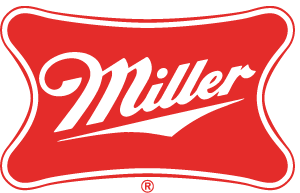 The Miller Brewing Company is an American beer brewing company headquartered in Milwaukee, Wisconsin. The company has brewing facilities in Albany, Georgia; Chippewa Falls, Wisconsin; Fort Worth, Texas; Irwindale, California; Milwaukee, Wisconsin; and Trenton, Ohio. On July 1, 2008, SABMiller formed MillerCoors, a joint venture with rival Molson Coors to consolidate the production and distribution of its products in the United States, with each parent company's corporate operations and international operations to remain separate and independent of the joint venture.
The Miller Brewing Company is an American beer brewing company headquartered in Milwaukee, Wisconsin. The company has brewing facilities in Albany, Georgia; Chippewa Falls, Wisconsin; Fort Worth, Texas; Irwindale, California; Milwaukee, Wisconsin; and Trenton, Ohio. On July 1, 2008, SABMiller formed MillerCoors, a joint venture with rival Molson Coors to consolidate the production and distribution of its products in the United States, with each parent company's corporate operations and international operations to remain separate and independent of the joint venture.
The joint venture ended after the SABMiller operation was acquired by Anheuser-Busch InBev (AB InBev) on October 10, 2016. The new company is called Anheuser-Busch InBev SA/NV (AB InBev). On October 11, 2016, the company sold the Miller brand portfolio outside the US and Puerto Rico to Molson Coors, which also retained "the rights to all of the brands currently in the MillerCoors portfolio for the U.S. and Puerto Rico".
Molson Coors is the sole owner of Miller Brewing Company and plans to keep the MillerCoors name and the Chicago headquarters and to operate the company in much the same manner as before October 11, 2016.

The joint venture ended after the SABMiller operation was acquired by Anheuser-Busch InBev (AB InBev) on October 10, 2016. The new company is called Anheuser-Busch InBev SA/NV (AB InBev). On October 11, 2016, the company sold the Miller brand portfolio outside the US and Puerto Rico to Molson Coors, which also retained "the rights to all of the brands currently in the MillerCoors portfolio for the U.S. and Puerto Rico".
Molson Coors is the sole owner of Miller Brewing Company and plans to keep the MillerCoors name and the Chicago headquarters and to operate the company in much the same manner as before October 11, 2016.
Brand/Importer Information:
The Freight Yard was a hobby shop that did custom decoration and special runs of other manufacturers' N Scale products. It sold its custom products under several brands or collections: Premiere Editions, by The Freight Yard and Dreams Design.
It was located in Anaheim, California and then moved to 2006 in Phoenix, Arizona.
Established in the late 1980s, it stopped business under this name by the end of the 2000s.
The Freight Yard was owned and operated by Darren J. Cohen. Darren is now operating North Valley Trains.
The Freight Yard / Premiere Editions runs are usually available in series of two to twelve different numbers (suffixed A to M, with I not used).
The first two digits of the stock number correspond to the release year (9x being 199x, and 2x being 200x).
It was located in Anaheim, California and then moved to 2006 in Phoenix, Arizona.
Established in the late 1980s, it stopped business under this name by the end of the 2000s.
The Freight Yard was owned and operated by Darren J. Cohen. Darren is now operating North Valley Trains.
The Freight Yard / Premiere Editions runs are usually available in series of two to twelve different numbers (suffixed A to M, with I not used).
The first two digits of the stock number correspond to the release year (9x being 199x, and 2x being 200x).
Item created by: CNW400
on 2019-11-04 13:50:03
Last edited by: Alain LM on 2022-09-25 05:41:23
If you see errors or missing data in this entry, please feel free to log in and edit it. Anyone with a Gmail account can log in instantly.
Last edited by: Alain LM on 2022-09-25 05:41:23
If you see errors or missing data in this entry, please feel free to log in and edit it. Anyone with a Gmail account can log in instantly.


